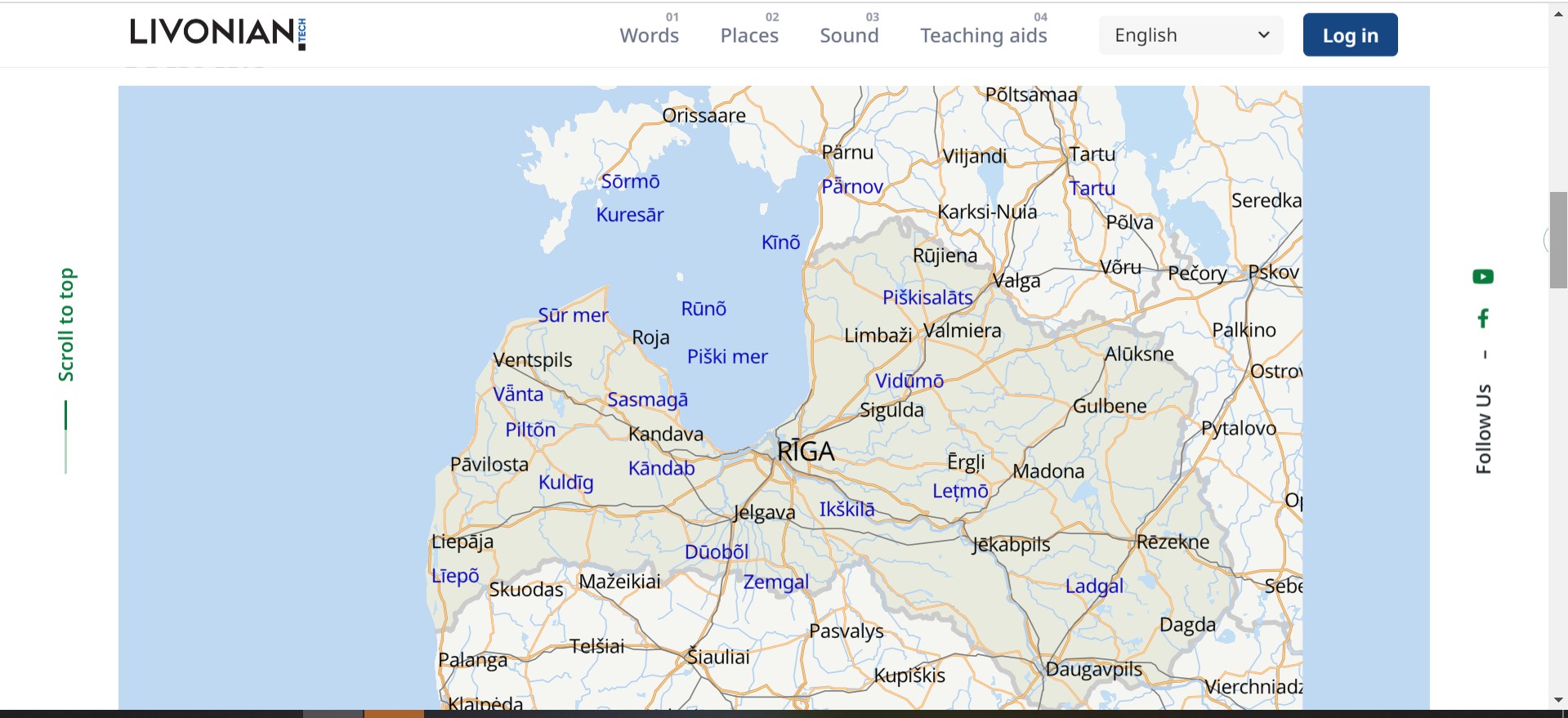* ESC - закрити вікно пошуку
LANGUAGE
A guide to the history of oppression of the Ukrainian language
29.03.2023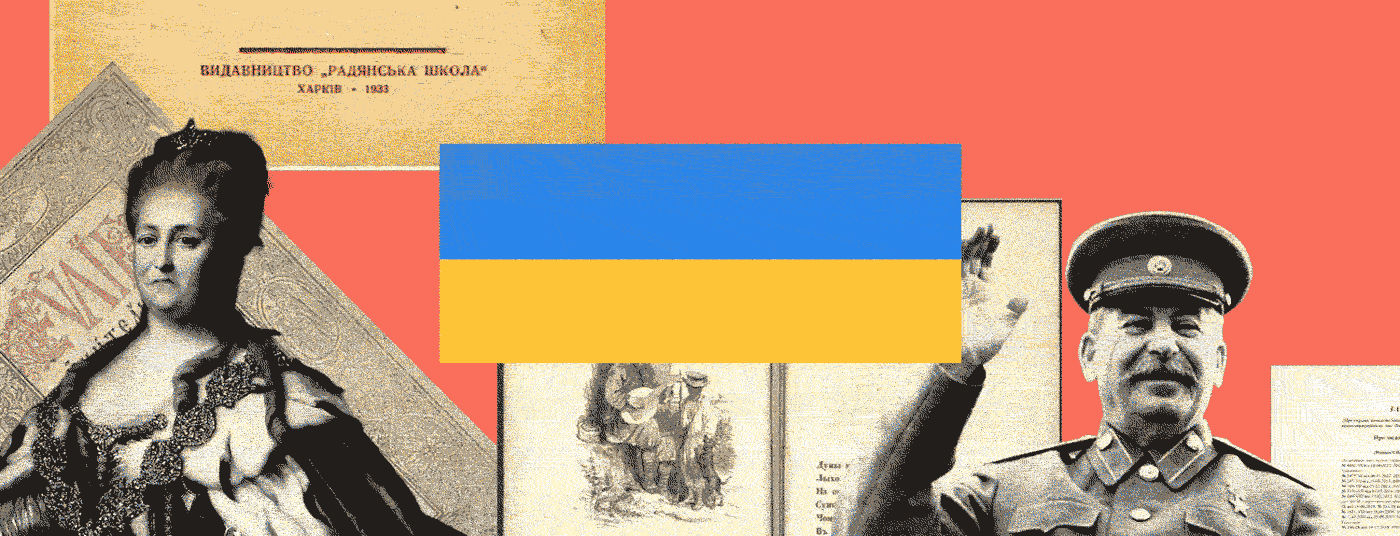
Let’s start right away with the conclusions: every person who lives in Ukraine and communicates in the Ukrainian language is exposed to the danger of discrimination on the basis of language. No, we are not in the world of Kafka or Orwell. Yes, we are in the 21st century. And in this century, when humanity, it would seem, should focus on the conquest of outer space, in Ukraine until recently, just speaking a phrase in Ukrainian could not only result in one hearing the disparaging remark “speak normally” said in Russian, but also result in you getting a skull fracture, as happened in 2019 with Ukrainian activist Artem Myroshnychenko.
Even not so long ago, before the beginning of the Russian-Ukrainian war, a large number of foreigners, only superficially familiar with the history of countries that do not directly border their homeland, sincerely did not understand and wondered how discrimination against the Ukrainian language could exist, if Ukranian is the state language? Well, how, for example, can a Pole who speaks Polish in Poland feel discriminated against? Or a German when speaking German in Germany? Nonsense. The more informed ones, however, recalled Ireland, Belarus, or the Baltic countries and fell silent.
It’s not even about foreigners: before the start of the war, some Ukrainians actively denied that they somehow experienced discrimination in Ukraine on the basis of language. But this turned out to be true only in those cases when they used not the Ukrainian language, but… Russian.
It is difficult for both foreigners and Ukrainians traumatized by the empire to understand why, until recently, it was considered normal to distribute Russian-language products on the book market of Ukraine, the number of which many times exceeded the Ukrainian-language ones. Why was teaching in Russian in universities, schools and kindergartens considered normal, as well as the dominance of the Russian language on TV and radio, on the Internet and social networks? Why was the Ukrainian language directly or implicitly, but deliberately relegated to the background, and both for an ordinary foreigner not immersed in the situation, and for a non-Ukrainian-speaking resident, it had to look like an ordinary, normal, self-directed process of language development.
The history of linguicide, that is the destruction of the Ukrainian language, covers more than four centuries, the coverage of which is devoted to volumes of scholarly works. Below, we will try to briefly highlight the most revealing events for each century, which led to the systematic erasure of the Ukrainian language and identity on Ukrainian territory. And if we, as Ukrainians, understand this 400-year-long prehistory, it increases the chances of avoiding another round of linguicide and not becoming the last generation to speak Ukrainian as the state language.

The Moscow church was the first to russify Ukraine: Ukrainian as a heretical language
Decree of Tsar Michael on a petition of the Moscow Patriarch Filaret to seize and burn at the stake all copies printed in Ukraine of the “Didactic gospels” by Kyrylo Stavrovetsky on charges of heresy. With this order, the Tsar forbade purchasing or possessing any books of “Lithuanian print” under the threat of public corporal punishment and patriarchal curse.
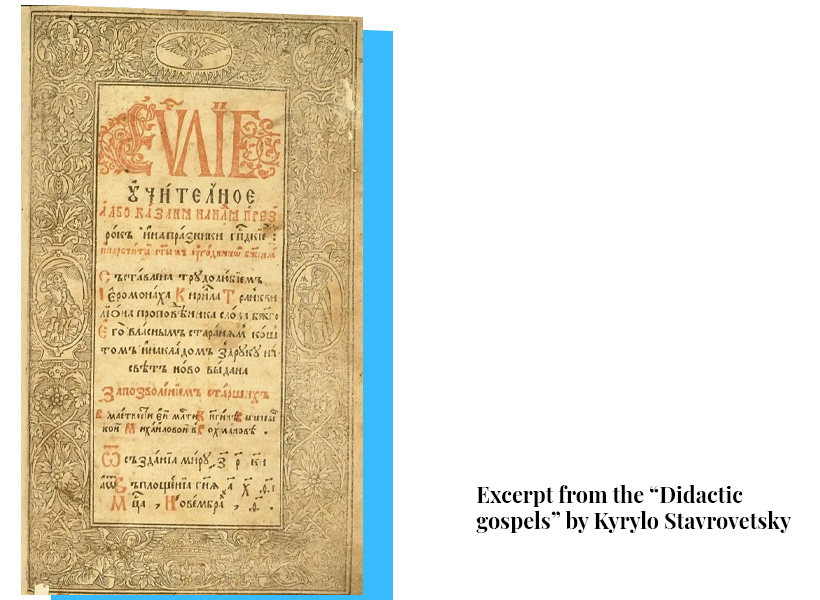
What kind of heresy provoked bonfires of books in Moscow and a ban to purchase any Ukrainian books? Historian Mykola Kostomarov described it as follows:
“Evaluation of this work [Didactic gospels] was entrusted to two Moscow scribes: Epiphany abbot Ilia and cathedral key keeper Ivan Shevel. As they didn’t know the language in which the work of the South Russian writer was written, they found a heretical meaning in grammatical peculiarities and in the meaning of words that were incomprehensible to them” (M. Kostomarov. Russian History in Biographies of its main figures).
The Polish king canceled ancient privileges and ordered all documents to be printed only in Polish and Latin. The Ruthenian (Old Ukrainian) language ceases to be the state language and ceases to develop as such, the threat of Polonization of Ukrainian territories increases.
The Kyiv-Pechersk Lavra monastery was not allowed to print any books without the permission of the Moscow Patriarch. The Moscow Church seeked to lead the cultural, educational and church life in Ukraine.
The Russian Orthodox Church condemned and anathematized new Kievan books by the enlightenment scholars Petro Mohyla, Sylvester Kosiv, Kyrylo Stavrovetskyi, Symeon Polotskyi, Lazar Baranovych and others, written in Ukrainian literary language of the time (some of these books later became the basis of patristic literature in Moscovia and the Russian Empire).
A law was passed prohibiting the import of Ukrainian publications into the Moscow state. At the same time, censorship was introduced to control the activities of Ukrainian book publishers.
Decision of the General Sejm of the Polish-Lithuanian Commonwealth on the introduction of the Polish language in the courts and institutions of the Right-Bank Ukraine. The Polish language expanded its area of existence at the expense of Ukrainian territories. The development of the Ukrainian language in the field of legal proceedings was hampered, it became impossible to enrich the terminological system of the business Ukrainian language due to the lack of a text base.

The Russian government: tsarism against everything Ukrainian
Decree on mandatory censorship of all Ukrainian books in Moscow. The Treaty of Pereiaslav, signed by Bohdan Khmelnytsky in 1654, provided formal grounds for strengthening the intervention of Moscow tsarism in Ukrainian affairs, which sought to control everything that influenced the development of the Ukrainian language (printing, education, fiction, theater, and the press). The offensive against the Ukrainian publishing began with renewed vigor. Imposing ideological restrictions is one way to slow down the development of genre diversity in a language.
Decree of Peter the Great reducing the number of students at the Kyiv-Mohyla Academy from 2,000 to 161. This reduction, combined with the transfer of the best scientific and educational minds from Ukraine to Moscovia (among them hierarchs Dymytrii Tuptalo, Stefan Yavorskyi, Havryil Buzhynskyi, Rafail Zaborovskyi, etc.), lead to erosion and weakening of the intellectual and spiritual potential of Ukraine.
Peter I’s decree banning the printing of new books in the original liturgical and book language of Ruthenian Ukraine. Ukrainian books were ordered to be identical to Moscow books, removing from them Old Ukrainian texts so that they did not have a “special dialect”. Another decree in a series of similar ones, which contributed to the inhibition of the development of the Ukrainian language and its stylistic diversity.
The introduction in Ukraine of book censorship “for the sake of correction and harmony with Russian ones” and the prohibition of the Chernihiv printing house to publish books, which led to its decline.
The Moscow Synod ordered the Kyiv-Pechersk Archimandrite to ensure that the spelling of words and accents were observed only according to the Moscow edition of the Church Slavonic language, and not to publish any books other than church books without the permission of the Synod. Such an attempt to unify the pronunciation of different editions of the Old Bulgarian language by bringing it closer to Russian destroyed the identity of the Ukrainian edition of the Old Bulgarian language.
Peter II ordered all state decrees and orders to be rewritten from Ukrainian into Russian. Lexico-grammatical enrichment and expansion of the functioning of the Russian language by using the resources of the Ukrainian language.
Empress Anna Ivanovna ordered the confiscation of books of old Ukrainian printing from churches and educational institutions, and to “teach sciences in our own Russian language.” In four years, according to the imperial decree, the imperial authorities would personally address the Metropolitan of Kyiv to remove old church books of Kyiv printing and make sure that church services were performed only according to the corrected texts.
The destruction of the Zaporozhian Sich resulted in the closure of Ukrainian schools at the regimental Cossack chancelleries. Even earlier, the institute of itinerant deacons, which ensured wide access to primary education in Ukraine, was banned: priests were forbidden to employ Ukrainian itinerant deacons as school teachers.
Circular banning lectures in Ukrainian at the Kyiv-Mohyla Academy and introducing Russian as a compulsory language in all imperial schools. Secret circulars allowed censors to remove from historical documents places where the Ukrainian language or Ukrainian people were mentioned.
The Synod ordered all the churches of Ukraine to celebrate the Divine Liturgy “in the voice typical to the Russian dialect” (until now, the Church Slavonic texts were read with the Ukrainian pronunciation according to the original tradition of Ruthenian Ukraine). A year later, Catherine II supported the synod by ordering all the churches of the empire to celebrate the Divine Liturgy in Russian (i.e. Church Slavonic in the Russian edition). One of the consequences of this policy was the lack of translation of the Bible into the native language of one of the most numerous peoples of the Russian Empire – Ukrainian – until the XIX century.
The decree of Catherine II on the confiscation of monastery and church lands and estates in Ukraine resulted in the closure of 46 monasteries. It caused a serious blow to Ukrainian education, as the monasteries maintained schools.
The Education Committee of the Polish Sejm ordered all Ruthenian (Ukrainian) church schools to close and removed the Ukrainian language from all other schools.
In Petersburg, on the initiative of Catherine II, the “Comparative Dictionary of All Languages” was published, in which the Ukrainian language was listed as Russian, distorted by Polish. This imperial myth will be repeatedly replicated over the centuries, and today it remains a reliable sign of a pseudo-scientist.
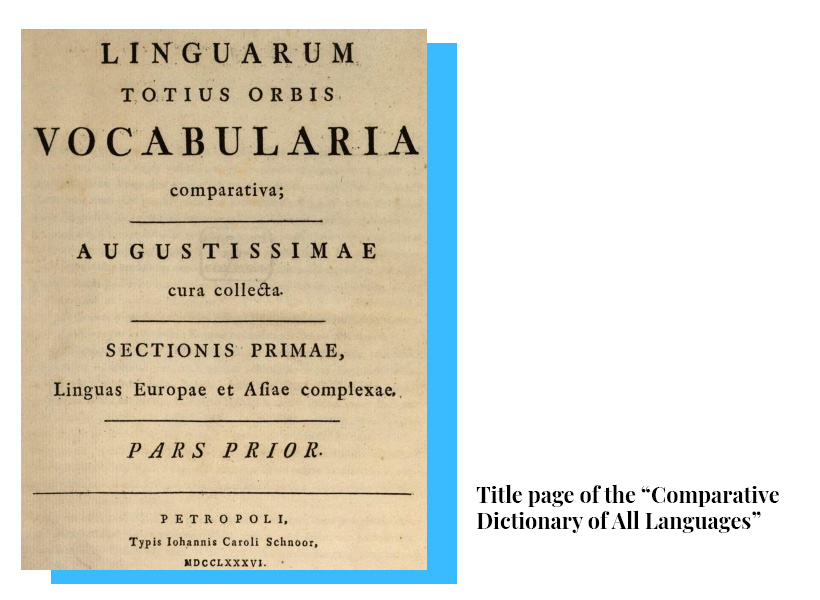

The Russian Empire continues the war against everything Ukrainian
Alexander Shishkov, the Minister of Public Education of the Russian Empire, made the thesis “the public education throughout the empire, despite the diversity of faiths and languages, must be purely Russian” as one of the main points of his administration.
The censorship regime became much stricter, especially after the police began to intervene. One example of its work was the prohibition in 1842 of the published master’s thesis of Mykola Kostomarov, a young historian from Kharkiv University, “On the causes and nature of the union in Western Russia”. The Minister of National Education Sergey Uvarov recorded the names of all the professors who responded positively to its publication, forced Kostomarov to collect all the distributed copies of the book and report on it, and also offered the author to write a new thesis. A year and a few months later Kostomarov wrote a new work entitled “On the historical significance of Russian folk poetry” and successfully defended it. However, in 1848 he was sent to Saratov, and the secret instruction of the III Department explained: “Do not allow him to teach and cooperate with the press.”
Education in the right-bank Ukraine was reorganized on the empire-wide principles and all teaching was transformed into Russian language.
Censorship of the Russian Academy of Sciences “lost” the manuscript of the “Dictionary of the Ukrainian language” compiled by Pavlo Biletskyi-Nosenko. His manuscript of the Ukrainian language grammar was also “lost”. The failure with the first dictionary did not discourage Biletskyi-Nosenko, and he began to compile a new one.
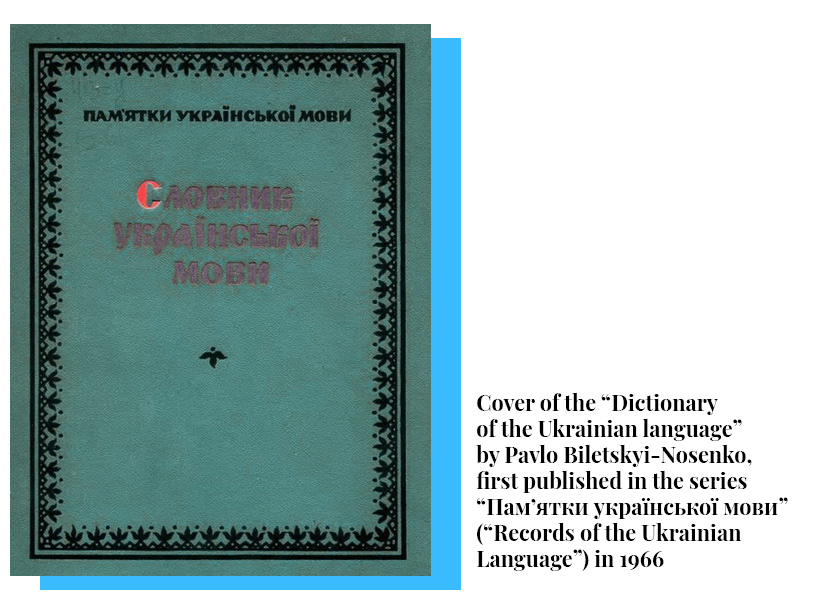
It was the largest Ukrainian dictionary of the first half of the nineteenth century (it had 380 pages and more than 20 thousand dictionary entries), but its potential was not fully used. It did not have a significant impact on the development of Ukrainian lexicography in the nineteenth century precisely because the author was not able to publish it back then, not least because of the “era of censorship terror”: the author did not agree with the changes proposed by the reviewer Mykhailo Maksymovych and continued to work on the dictionary (it was not finally banned, and the author was not punished for free thinking). The dictionary appeared in print only in 1966 (edited by the famous linguist Vasyl Nimchuk).
The dictionary contains rich material: there are the author’s records of Ukrainian dialects of the left-bank Ukraine, examples from fiction works of the time and vocabulary from ancient sources. One of the first attempts to cover the history of the Ukrainian language was the introductory text to the dictionary “О языке малороссийском” (“On the Little Russian language”), and the study “О придаточных окончательных корнях слов и слитных предлогах как новых источниках изображения идей” (“On adjective final roots and fused prepositions as new sources of image of ideas”) was perhaps the first work on Ukrainian derivatology.
Destruction of the Brotherhood of Saints Cyril and Methodius and intensification of brutal persecution of Ukrainian language and culture. By order of Nicholas I, the Minister of Internal Affairs banned the sale of the best masterpieces of Ukrainian-language authors and works that touched upon the history of Ukraine, like Shevchenko’s “Kobzar”, works by Mykola Kostomarov, Panteleimon Kulish and others. Since then ten long years of Taras Shevchenko’s soldier’s hard labor began by order of Nicholas I (1847-1857), “under the strictest supervision, with a ban to write and draw”, which for the artist and writer was tantamount to torture. Such a blow to the greatest Ukrainian talent of that time actually meant a blow to the entire Ukrainian literature, language and art, the development of which was significantly slowed down, since one of its most prominent participants was not able to fully participate in the literary and artistic process.
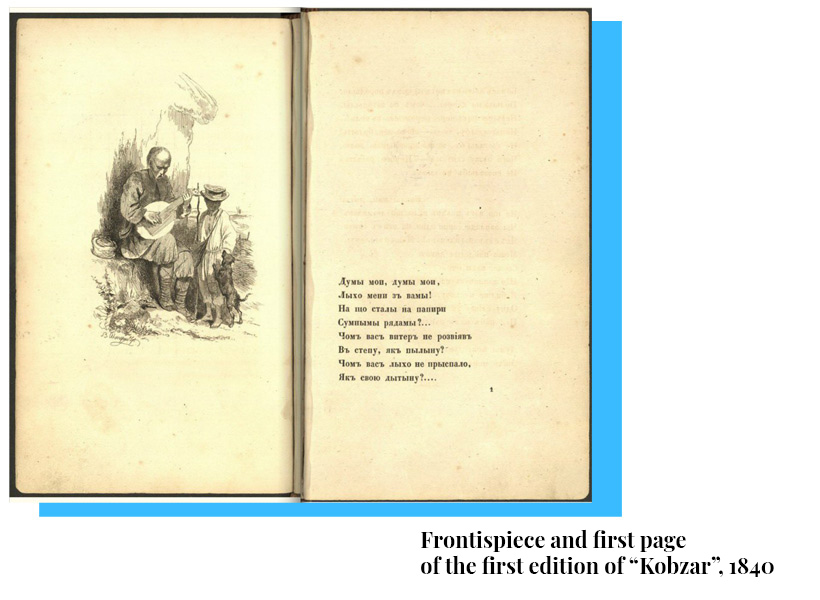
The order of the Minister of National Education Sergei Uvarov to the trustee of Kyiv educational district Aleksandr Traskin obligating Kyiv University teachers to give preference to Russian language, literature, history and history of law in teaching and research in order to teach young people “to continue to think and feel in Russian”, because only in this way “future members of society will form one big family with the same thoughts, with the same will, with the same feelings.”
An order to the censorship authorities so that “works in the Little Russian dialect, written essentially for distribution among the common people, were printed in Russian letters only.”
The Ministry of Religion and Science of Austria-Hungary attempted to replace the Ukrainian Cyrillic alphabet with Latin in Eastern Galicia and Bukovina.
The Valuev Circular, issued on July 30, 1863, was a secret order of the Minister of Internal Affairs Pyotr Valuev to the censorship committees. By it, the Russian Empire banned the language itself, postulating that “there was, is not and could not have been a separate Little Russian language”, and that “their dialect, used by the common people, is the same Russian language, only corrupted by the influence of Poland.” Ukrainian book printing was completely banned: from alphabet books, educational literature, scientific publications to periodicals. The only exception was made for works of fiction, which were strictly censored. As a result, over the next seven years, only 20 Ukrainian books were published – the same total as had been published in 1862, the year preceding the order.

Adoption of the Charter on the primary school in which education was to be conducted only in Russian. The ousting of the Ukrainian language from the sphere of education was fully in line with the ultimate goal of the imperial Minister of Education Dmitry Tolstoy and did not leave the Ukrainian language any hope for normal functioning.
Baron Corf, Alexander II’s aide-de-camp, developed a program to combat the Ukrainian language by “flooding the region with extremely cheap Russian books,” which “would deprive Little Russian literature of any chance of significantly expanding the circle of readers.” The emperor’s approval was not long in coming: “Quite reasonable. The idea is very good. I will figure out how to execute it.” Centuries pass, history repeats itself.
The great robbery of Ukrainian archives. After the judicial reform thousands of poods of archival materials were taken to Moscow. According to the order of the Ministry of Justice dated 3.12.1866, a large number of documents of liquidated institutions from Volyn, Kyiv, Yekaterinoslav, Podil, Kherson and Chernihiv governorates were taken there.
Introduction of the Polish language as the official language of education and of the administration of Polish Eastern Galicia. Parallel processes also occurred in another empire, which included Ukrainian lands.
The Minister of Internal Affairs received the right to ban the publication of particularly harmful books and magazines that were published without prior censorship. With the introduction of punitive censorship, the entire edition of books that were subject to prohibition was destroyed, which led to material losses of publishers. From November 20, 1864 to 1872, 90 authors, editors and publishers were prosecuted. The authorities passed final guilty verdicts in 65 cases against 86 people. The acquitted were 94 cases and 13 people. Twenty-one cases remained unresolved.
The Ems Decree, signed by Emperor Alexander II on May 30, 1876 in the German town of Ems, was a kind of continuation and expansion of the Valuev Circular. The decree prohibited: 1) The importation of books and brochures in Ukrainian into the territory of the Russian Empire; 2) The publication of original works and translations into Ukrainian without censorship permission, except for historical documents and records (preserving the spelling of the originals) and works of fiction (but not in Ukrainian spelling, but only in accordance with the generally accepted Russian spelling); 3) Theatrical performances and printing of Ukrainian texts on sheet music, including national songs.
The ban on printing lyrics to music in Ukrainian led to a number of absurd situations. Thus, due to these bans, the famous choir of students of the University of St. Volodymyr was forced to perform the Ukrainian folk song “Дощик, дощик крапає дрібненько” in French in Kyiv. Olena Pchilka had to sign her “Collection of samples of Ukrainian embroideries” in French as well.
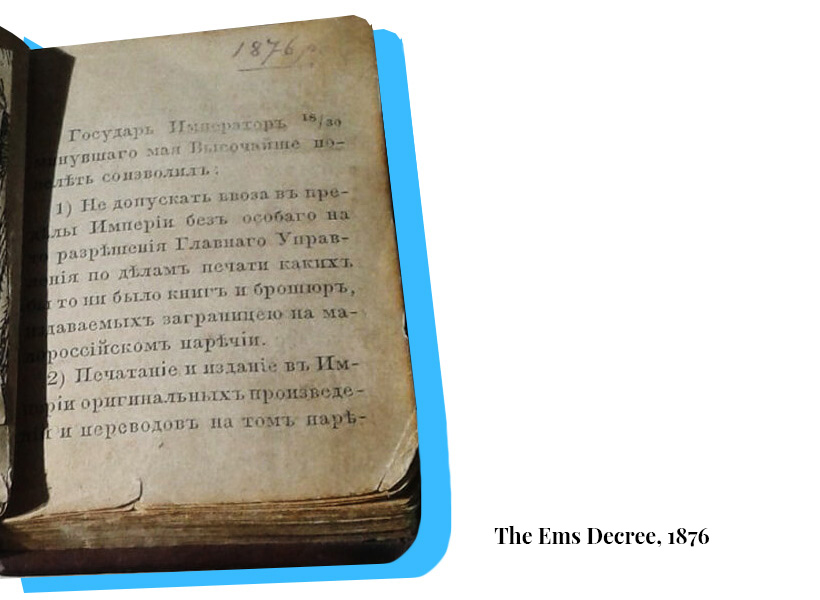
Especially sophisticated imperial sadism was manifested in the fact that the prohibition against performing theatrical works in Ukrainian extended only to the territory of Ukraine: in other cities of the empire, Ukrainian plays on family and domestic themes were not prohibited, in particular, in St. Petersburg, there were staged plays like “Natalka Poltavka”, “The Courtship at Goncharivka”, “Kateryna”.
Local administrations were required to create lists of teachers in universities who had “Ukrainophile tendencies”, so that these teachers could be relocated to work in Russia and replaced with “Great Russians”. It was also planned to pay extra money to teachers “for the Russification of the region”. Local administrations were ordered to strengthen supervision to ensure that primary schools did not teach in Ukrainian, and that books in Ukrainian were removed from libraries.
The more serious consequences of such a policy of the Russian Tsardom were the termination of the South-Western Department of the Geographical Society, the closure of the newspaper “Kyiv Telegraph”, the dismissal and expulsion from the country of some teachers of the University of St. Volodymyr in Kyiv, in particular Pavlo Chubynsky and Mykhailo Drahomanov. And the following year, not a single book was printed in the Ukrainian language in Ukraine: book printing was forced to emigrate to the West. It was then that Galicia became known as the “Ukrainian Piedmont”, uniting Ukrainophiles who had previously been divided by imperial borders.
In 1884, 1892 and 1895, the Ems Decree was supplemented with new bans, in particular on the publication of books on historical topics, children’s books and books about the life of the intelligentsia.
The Ems Decree was valid for almost 30 years and lost its force only after 1905, when new rules of book publishing in the Russian Empire were approved.
A decree by Alexander III banned using Ukrainian language in official institutions and baptizing people with Ukrainian names.
The circular of the General Directorate of Press Affairs issued a categorical ban on censorship committees and individual censors of internal censorship to consider Ukrainian literary works written in “kulishivka”. The authors were required to use only Russian spelling.
Kulishivka is a Ukrainian phonetic spelling, named after its author Panteleimon Kulish. Developed in the late 1850s, it became the basis for subsequent Ukrainian orthographies.
Kyiv’s separate censor received an order of the General Directorate of Press Affairs which prohibited translations of Russian-language works into Ukrainian, and required to consider all works in Ukrainian “with special strictness and attention” in order to reduce the number of Ukrainian publications.

Ukrainian language under the oppression of one empire in three guises
Resolution of the VII Noble Congress in Moscow on exclusively Russian-language education and the inadmissibility of the use of other languages in educational institutions of the Russian Empire. The Russification policy of the Russian Empire is gaining momentum.
Resolution of the Synod of the Russian Orthodox Church on taking measures to withdraw from libraries, schools and reading rooms, as well as from sale, St. Petersburg editions of “Kobzar” by Taras Shevchenko.
Ukrainian books were becoming a rarity in a country where Ukrainians were the second (after Russians) largest people: the share of Ukrainian among the printed products of the Russian Empire is illustrated by the list of books published in 1911: 25,526 titles in Russian, 1,664 in Polish, 965 in Hebrew and Old Hebrew, 920 in German, 608 in Latin, 519 in Estonian, 372 in Tatar, 266 in Armenian, and 242 in Ukrainian.
The circular of the trustee of the Kyiv educational district to the heads of secondary schools and directors of public schools prohibiting students from participating in the events celebrating the 100th anniversary of Taras Shevchenko. This ban caused mass demonstrations of students in Kyiv and other cities of Ukraine. Police units were sent against the demonstrators.

However, despite these bans, as well as mass arrests on the eve of the anniversary (February 23-24), thousands of demonstrations were still held not only in the largest cities of Ukraine, but also in Moscow and St. Petersburg.
Decree of Nicholas II banning the Ukrainian press. All Ukrainian newspapers and magazines, their regional branches, Ukrainian publishing houses were closed, it was forbidden to print anything in Ukrainian. Many Ukrainian figures were exiled from Ukraine.
Proclamation of the Central Committee of the RCP(B), and the Communist Party (bolsheviks) of the “theory of the struggle between two cultures” in Ukraine — urban, progressive, proletarian (Russian) and peasant, counter-revolutionary and backward (Ukrainian), in which the first one should win, and the task of communists is to support this “natural process”. Ukrainian culture and language once again found themselves on the lowest rung of the social hierarchy.
A law of the Polish Republic restricting the use of the Ukrainian language in administration, judiciary, education on Ukrainian lands under Polish control. Ukrainian schools became Ukrainian-Polish ones; the choice between Polish and Ukrainian was often made on the basis of parents’ votes, but it was usually a formality. As a result, the number of Ukrainian schools in Galicia decreased from 2,532 in the 1922-23 school year to 352 in 1937-39.
Kingdom of Romania’s law on the obligation to educate children only in Romanian schools. Ukrainians were considered not as a separate people with their own language and traditions, but as Romanians who “forgot their mother tongue”. The intensified Romanization of all types of school education was completed in 1927.
The final closure of the illegal (“secret”) Ukrainian university in Lviv, where more than 1,000 students studied at the philosophy, law, medical and polytechnic faculties.
Stalin’s letter to “Comrade. Kaganovich and other members of the Politburo of the Central Committee of the CP(B)U (Communist Party (Bolsheviks) of Ukraine) with a sanction to fight against the “national bias”, the beginning of the persecution of the activists of “Ukrainization”. Institutions supporting Ukrainian nationalism were also targeted: Ukrainian Church, the Academy of Sciences and the whole sphere of culture.
The beginning of a political campaign against “sabotage on the linguistic front”, during which the Institute of Ukrainian Scientific Language was liquidated, including a number of scientific commissions (dialectological, of the history of the Ukrainian language, of the normative grammar of the Ukrainian language, for compiling a dictionary of the living Ukrainian language, a historical dictionary of the Ukrainian language, an etymological dictionary). On their remains, however, was created the Scientific Research Institute of Linguistics, where only half of the old staff managed to get positions after the purges.
In the RSFSR (Russian Socialist Federal Soviet Republic), on the territories inhabited by Ukrainians, Ukrainian schools, secondary special and higher educational institutions and faculties were liquidated, newspapers and publishing houses were closed (in the Kuban, the Far East, Siberia and other places). To fight against the carriers of the Ukrainian language, culture and consciousness, an artificial famine was organized in the territories of Kuban and Don, inhabited mainly by Ukrainians. The change of ethnic and, accordingly, linguistic composition of the population was also carried out through mass resettlement of Russians to extinct or deported to Siberia Ukrainian villages.
Holodomor. The genocide of the Ukrainian people by famine, which killed, according to various estimates, between four million and 10.5 million people. One of its consequences was the change in the ethnic and, accordingly, linguistic composition of the population of Ukraine, reinforced by the mass resettlement of Russians to extinct and deported Ukrainian villages.
The implementation of the secret decree “On measures to eliminate kulak farms in areas of continuous collectivization” (30.01.1930) was carried out as a real military operation. It took place in three stages. During the first (January-October 1930), 31,593 peasant families (146,229 people) were evicted from the Ukrainian SSR, and during the second (March-September 1931), 32,127 peasant families (131,236 people) were evicted to the northern regions of the Ural region. In total, from 1928 to 1931, 352 thousand farms were destroyed and 1.5 million people were robbed. The third stage was implemented in 1932-1933: about 1,900 families were evicted in late 1932 and early 1933, and 9,500 families in late 1933 (R.Tesliuk. The Genocide of Ukrainians: Deportations and Immigration. Holodomor Research Institute, 2022).
The order of the new management of the People’s Commissariat of Education of the Ukrainian SSR to organize the commission, whose task was to reject “the artificial separation of the Ukrainian language from the Russian language in dictionaries” and to eliminate “nationalist spelling rules that oriented the Ukrainian language to Polish and Czech bourgeois cultures”. The program to “eradicate, destroy the roots of Ukrainian nationalism” in terms of terminology and grammar became fundamental regarding the “neutralization” of dictionaries and orthography in 1928. Words widely used in western Ukraine were often banned because they differed from Russian ones.
The new Ukrainian spelling was approved. The letter ґ was removed from the alphabet. The norms of Russian spelling were extended to certain rules and spelling norms, and the section on foreign words was rewritten entirely according to the Russian model. In total, 126 amendments were made. The entire publishing business was transferred to the new spelling immediately, even before its approval and publication. In a year, the orthography book will be released with a foreword by A. Khvyla, which stated: “The main corrections concern the elimination of all rules that… put a barrier between the Ukrainian and Russian languages”.

Resolution of the Central Committee of the CP(B)U to stop Ukrainization. Four thousand teachers were dismissed from schools as “class-hostile elements”. The number of Russian schools and classes increased. Most Ukrainian writers were killed.
Abolition in Romania of the Ministerial Decree of December 31, 1929, which allowed several hours of Ukrainian language per week in schools with a majority of Ukrainian students.
A special order of the Ministry of Education of Romania was issued on the dismissal of all Ukrainian teachers who demanded the return of the Ukrainian language to schools “for hostile attitude to the state and the Romanian people”.
Under the pretext of the murder of Sergei Kirov, Ukrainian cultural figures were sentenced to death, including writers and artists Hryhoriy Kosynka, Kost Bureviy, Dmytro Falkivskyi, Oleksa Vlyzko, Ivan and Taras Krushelnytskyi and others. “Consolidated lists of literature to be withdrawn from sale, libraries and educational institutions” were signed for printing.
About 20 institutes of the Academy of Sciences were liquidated, including the Institute of Shevchenko Studies, the Institute of Jewish Proletarian Culture, the Institute of Polish Proletarian Culture, etc. The “Orthographic Dictionary” by Dora Levy, Hryhoriy Levchenko, Lyudmyla Rak was published, and on its basis the “Dictionary of Medical Terminology” was published after being “cleared of harmful terminology”. Since then, terminological work in Ukraine was suspended for decades.
The Resolution of the USSR Council of People’s Commissars and the Central Committee of the CPSU(B) “On compulsory study of the Russian language in schools of national republics and regions” substantiated and ensured compulsory study of the Russian language throughout the USSR.
Operation Vistula: resettlement of a part of Ukrainians from ethnic Ukrainian lands of Kholmshchyna, Posyannya, Podlasie and Lemko Region to Western Poland. Their placement in small groups among the Poles, rather than in large groups, was aimed at accelerating their assimilation by the local population. Poles settled in their place, and they were forbidden to return to their native places. The result was the marginalization of the language, narrowing the area of its functioning with the subsequent loss of the native language in the next generation.
Resolution of the Plenum of the Central Committee of the CPSU “On strengthening the connection of school with life…”, which proclaimed that the study of the languages of the Union republics in schools was optional; the study of all languages except Russian was at the request of the parents of pupils.
Order of the Ministry of Education of the USSR to write and defend all dissertations only in Russian and to approve them only in Moscow. With the shift of the center of Ukrainian scientific life to the metropolis, the Ukrainian scientific language loses status and gradually begins to decline.
Communist Party bans anniversary celebrations of the museum dedicated to Ivan Kotlyarevskyi in Poltava. The absence of a worthy commemoration of the classic of Ukrainian literature and the founder of the new Ukrainian language is not just a form of propaganda, but also reflects the USSR’s real attitude toward the Ukrainian language and culture.
Anniversary celebrations of Kotlyarevskyi’s masterpiece “The Eneid” are banned. According to the Soviet canon, the history of the formation of the Ukrainian literary language cannot be longer than that of the Russian language, which is assigned to be the eldest among the languages of the three fraternal peoples. And the celebration of the anniversary may shake faith in imperial linguistic theory and historiography.
Resolution of the Central Committee of the CPSU “On Preparations for the 50th Anniversary of the Union of Soviet Socialist Republics”, which for the first time proclaims the creation of a “new historical community — the Soviet people”, the official course of denationalization.
Resolution of the CPSU Central Committee and the USSR Council of Ministers “On measures to further improve the study and teaching of the Russian language in the Union republics” (Brezhnev Circular). Another round of imposing the Russian language.
Resolution of the Central Committee of the CPSU and the Council of Ministers of the USSR “On additional measures to improve the study of the Russian language in secondary schools and other educational institutions of the Union republics” (Andropov Decree). It provided for the payment of 15% higher salaries to Russian language teachers compared to Ukrainian language teachers. The Ukrainian language was becoming non-prestigious not only ideologically, but also financially.
The Ministry of Culture of the USSR ordered to translate work processes and documents in all museums of the Soviet Union into Russian.
Resolution of the CPSU Central Committee on “legislative consolidation of the Russian language as the state language” in the USSR.
The Supreme Soviet of the USSR adopted the Law on the Languages of the Peoples of the USSR, which granted Russian the status of the official language. About 99% of films in Ukraine were shown in Russian, in video salons — 100%; 70-80% of fiction on the shelves of bookstores was in Russian; 90% of classes in universities, technical schools and vocational schools were held in Russian; 90% of scientific literature was published in Russian.
Attempts to give the Russian language an official status. A quote from the inaugural speech of President Leonid Kuchma: “In the near future, I intend to propose amendments to the current legislation in order to grant the Russian language an official status while preserving the state status of the Ukrainian language.”
Famous linguist Larysa Masenko noted that “the process of Russification has not only not stopped, but has actually expanded”. In Ukraine, there are 54 periodicals in Russian and seven in Ukrainian per 100 citizens, i.e. Ukrainian ones are almost eight times less. Two-thirds of the Ukrainian book market consists of imported books in Russian.

Russian-Ukrainian war: and again there is something to fight for
The Council on Language Policy under the President of Ukraine, headed by literary critic Mykola Zhulynskyi, was liquidated. At the same time, the sector for monitoring language and national policy within the Department of Humanitarian Development of the Secretariat of the Cabinet of Ministers of Ukraine was abolished.
The Verkhovna Rada of Ukraine adopted in the first reading the Law “On the Principles of State Language Policy” No. 5029-VI, commonly known as the “Kivalov-Kolesnichenko Law”. This law introduced the concept of regional languages of Ukraine and established a low percentage of native speakers (10% of the population of a certain region, and in some cases less than 10%), in the presence of which a language could be considered regional in a certain territory. Allowing the free introduction of regional languages “in the work of local state authorities and local governments, in state and municipal educational institutions, as well as in other spheres of public life” actually made it possible not only to put the Russian language on a par with the state language in a number of Russified eastern and southern territories of Ukraine, but also to make it the only dominant language.
Although the authors of the law claimed that this law was developed in the spirit of European legislation and referred to the “European Charter for Regional or Minority Languages”, it was clear to many that in the conditions of hybrid war, when the state Ukrainian language actually needed protection, such statements were manipulative, and the law itself was disastrous for the state. Mykhailo Chechetov, a deputy from the Party of Regions, which almost entirely supported the bill, demonstrated the level of discussion by directly telling journalists after the vote: “We have tricked them (political opponents) like kittens.”
It is clear that such a law even at the stage of preliminary consideration caused violent protests from the public and experts, not only in Ukraine but also around the world. Thus, the World Congress of Ukrainians made a statement condemning the newly voted law, considering it as another step of the authorities “towards the official return of the Russian language in various spheres of state and public life and Russification of the population of Ukraine, and then — to the constitutional introduction of Russian as the second state language.” It also emphasized that this act contradicts the tenth article of the Constitution of Ukraine, according to which “the state language in Ukraine is Ukrainian,” as well as the European Charter for Regional or Minority Languages and the Framework Convention for the Protection of National Minorities, as the promotion of regional and minority languages should not be carried out at the expense of the state language.
The adoption of the law caused mass protests known as the “language Maidan”. The actions were held in many cities of Ukraine. Despite the protests and hunger strikes, the law was signed by Viktor Yanukovych.
On February 23, 2014, the Verkhovna Rada repealed the law “On the Principles of State Language Policy”, but the decision was not signed. On Feb. 28, 2018, after three years of consideration, the Constitutional Court of Ukraine declared the law unconstitutional due to violations of the procedure required for its adoption.
Since the beginning of the occupation of Donetsk and Luhansk regions and the Crimean peninsula, the Ukrainian language, literature and history of Ukraine as subjects of study have been removed by the occupiers from school curriculum, replaced by Russian ones with the corresponding ideological content. Textbooks and fiction were physically destroyed, teachers were forced to switch to Russian “standards of education” (language, programs, textbooks). All references to Ukraine were removed, even the word “Ukrainian” itself: for example, the naming “Ukrainian-language class” has changed to “classes with instruction in the language of the peoples of Donbass”. In 2019, there was not a single Ukrainian school left in Crimea.
After February 24, 2022, according to the Commissioner for the Protection of the State Language Taras Kremen, more than 100 cases of linguicide were recorded in the territories of Ukraine temporarily occupied by the russian federation as of October 2022, accompanied not only by threats and intimidation, but also by the use of physical force, restriction of freedom, abduction, torture and murder. It is about “the actual deprivation of the right of citizens to use, study and learn Ukrainian, discrimination and repression against persons who publicly manifest their Ukrainian national identity, in particular through communication in Ukrainian.”
Author: Olena Siruk
Translator: Maria Bragan
Editor: Jared Goyette
This publication is sponsored by the Chytomo’s Patreon community
що більше читаєш – то ширші можливості



